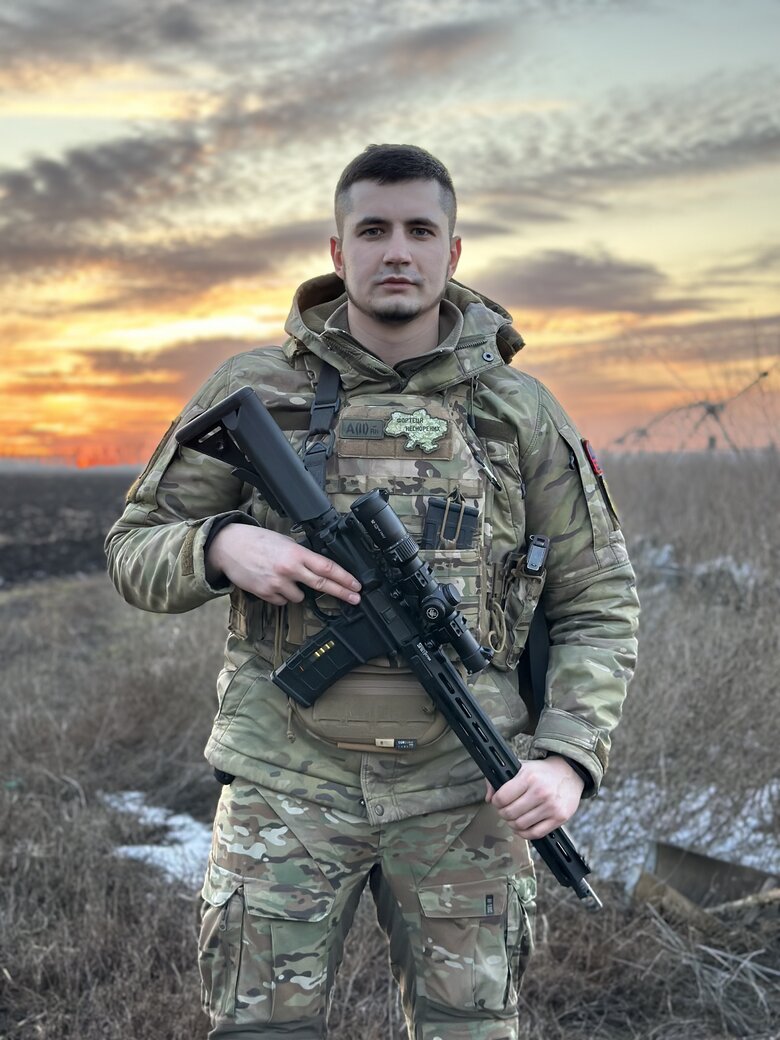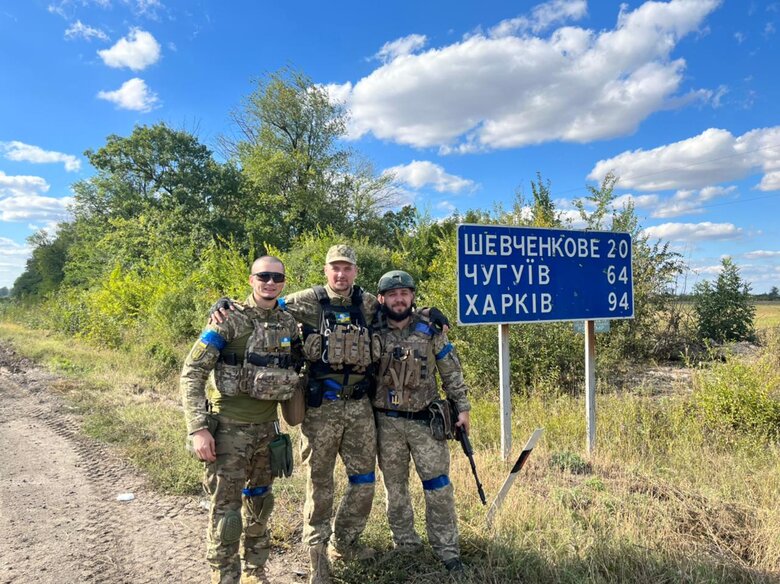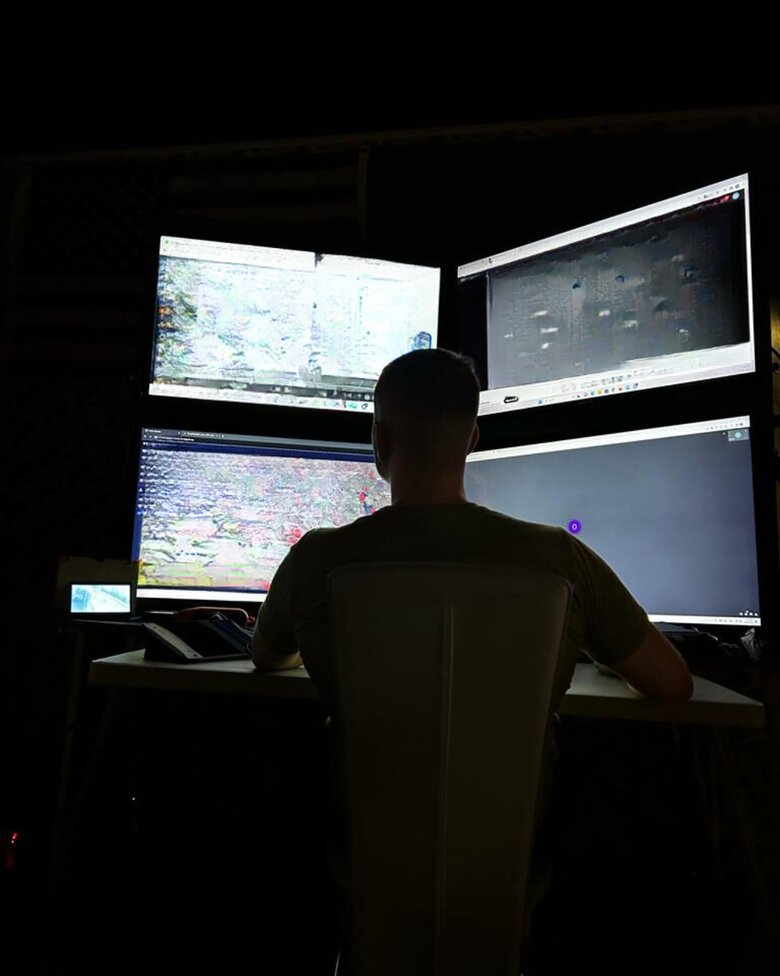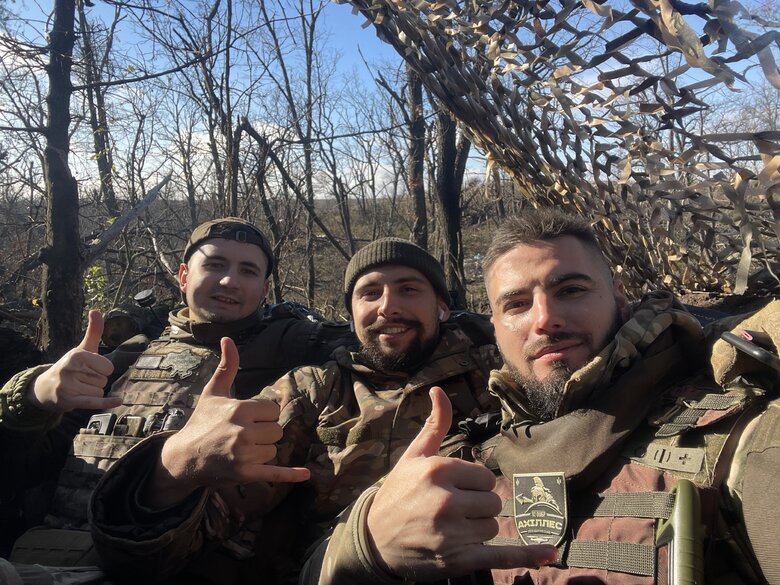Commander of Strike Company, call sign Banderas: "Most people have no restrictions on air pilotage. Basically, everyone can operate."
Before the full-scale invasion, Anton Shmahailo considered himself the biggest pacifist in his social circle. He did not believe in a big war and assured his friends and acquaintances that it would not happen. He was engaged in logistics - international rail transportation. But on February 24, 2022, everything changed and led Anton to the army.
Today, he commands the first Strike Company of the Unmanned Strike Aviation Systems Battalion "Achilles" of the 92nd SMB, which is fighting in the most intense directios of the frontline. His call sign is Banderas.
- "A few days before the full-scale operation, my friends and colleagues were very worried about the information about a possible attack," he recalls in our conversation at the beginning of his path to the army. - "I was the biggest pacifist and indifferent, calming everyone down and saying: "We've already been through this three times, including in 2021, when there were significant concentrations of Russian troops on the borders. Guys, everything is fine! The president promised barbecue!" So I was the main Arestovich at that time for each of them. But many of them were still worried. Some said they were going to mobilise. In the end, many left, and I, as the biggest pacifist, feeling responsible, decided that I had to go to war.
- So on 24 February you went to the military commissariat?
- Yes. I was told that there were no places and sent to the address of our battalion's TDF (Territorial Defence Forces) formation. I saw that the queue was about a hundred metres long. I stood in it. They recorded me - "had been put on notice" and promised to call me back. When I saw that the guy who promised me this had about 20 sheets of paper with lists, I realised that no one would call me back, I had to stand in line again. I waited the next day and the next.
- And did you get into the office?
- It was a bit different (smiles - O.M.). There are supposed to be four rifle companies in the TDF battalions. At that time, I think there were seven in ours. That is, we were manned and not going to take any more people. But a man with a hunting rifle said: "I am a company commander. Of the seventh company. Come to me!" We went over and were put on the list. I started my rapid career growth, because I immediately became a squad leader, and in 20 minutes - a deputy platoon commander (smiles - O.M.).
- Wow!
- They asked who could gather people, make lists, etc. I agreed. I worked on the formation of the platoon. While we were waiting for the documents to be processed, we conducted training, including tactical training. But unfortunately, I did not get into my group because there was a lack of weapons. The first platoons received them, but half of ours did not. Accordingly, the company was equipped fully and sent to perform tasks, but we stayed behind, waited for a day, and then we were assigned to a company headed by the well-known Achilles. So a series of accidents, in fact, brought me here, where I am now.
- Were you prepared? Did you know how to shoot at all?
- I did not know how to shoot. However, I had a general understanding of military affairs because my family was involved in the army. I had a base in physical training - I went in for sports. But I did not undergo any training.
- Where were you initially sent?
- We were formed into a company and sent to prepare the second line of defence in the Darnytskyi district of Kyiv. We had periodic sallies to the front line when there were hostilities in the Brovary district. But we did not take part in them. We were engaged in the second line of defence. We troubled ourselves - for example, they were involved in field communications in almost half of the Darnytskyi district.
- How long have you been in Kyiv?
- A little over a month. Then we received a combat order to move to the Kharkiv region. Along the way, we were relocated several times. Eventually, we arrived near Chuhuiv, took up the defence line, set up and prepared platoon strongholds, established communications, etc.
- Were you still a member of TDF?
- Yes, for a long time we were still part of the TDF. We were creative back then, in particular, we tried variants with remote mining and traps for the enemy. One day, during a routine inspection of the positions with the commanders, we saw a mortar firing and some commotion near it. We drove over to see what was going on. We saw the first miracle of engineering technology - Mavic-3 (smiles - O.M.), which allowed us to remotely see what was happening three or four kilometres away. It opened up new horizons for us: we could not just tolerate being constantly attacked, but try to respond. We chipped in, bought a couple of Mavic's and formed an aerial reconnaissance group. The guys from other units shared their experiences with us. Then we formed a second crew, and a third. In the end, half of our company was engaged in reconnaissance, while the other half continued to perform defence tasks in certain areas. We engaged some adjacent units and organized work on a wide section of the front (more than 30 kilometres) on interaction, counter-battery combat, planned destruction of the enemy and set up a system so that he could not even move to another area to make at least one shot from Grad because he was immediately defeated.
At the same time, we tried to engage in electronic reconnaissance - we deployed radio intercept points, analysed them, and as soon as we heard familiar call signs, we immediately sent our aerial reconnaissance vehicles there, deployed the guns and waited for the enemy. For a long time, if something strikes near Chuhuiv, for example, a single missile, it was just a nightmare for us - it was a fuckup! Because the work was set up in such a way that the enemy was completely quiet in that area. He made some attempts to conduct attack and assault operations, but they ended in major setbacks and significant losses of equipment.
Then our TDF Battalion went on rotation, and we took the initiative, so the commander of the 92nd Brigade, with the assistance of the artillery chief, left us in the area as a reconnaissance unit. Then came the Kharkiv counter-offensive, where we, as an advanced reconnaissance unit, ensured the rapid mobile advance of our troops.
- The Kharkiv counter-offensive was effective and spectacular. What do you remember most often from those days?
- I remember the complete disorganisation of the enemy. Our significant advantage at that time was the massive provision of our forward units with intelligence equipment, including Mavics. Due to this, we had a significant advantage over the enemy in situational awareness. It was a total. Even at the level of some brigades, the enemy was setting up fortifications to meet us at the front at a time when our units had long since entered their rear. There is a well-known case when a column was burned behind the village of Chkalovske: the enemy built it to retreat, and our units, in particular the third assault battalion of the 92nd Brigade, entered the flank and shot the Russians at point-blank range, and they did not understand what was happening until the last moment, how mobile and overwhelmingly superior everything was.
The Kharkiv counter-offensive was also successful because it was chosen in an area where the enemy had dug solid lines of fortification - trenches reaching one and a half to two kilometres - but they did not have the necessary manpower and, most importantly, did not have defence and fire systems in place. They knew that there would be a counter-offensive, but they did not understand in which directions. Previously, the enemy had attempted to break through the defences directly along the E-40 road. Several times, they tried to storm the village of Hrakove (a village in Chuhuiv district, Kharkiv region - O.M.). It was from that direction that the maximum amount of forces were accumulated. North of the city of Balakliia, the fortification lines were dug lazily, and the orcs walked around at ease. No one bothered to look out for anything there. You know, when we saw the plans for the offensive up to Kupiansk, we were a bit shocked, of course. It was such a very optimistic scenario. The first days were key because the enemy failed to realize in time that this was the main attack. When they began to be destroyed on this front line, they had the forces and means to stop it, but they did not have the necessary level of situational awareness and command of the situation. They were disoriented and started to run away. When we saw the convoys running away, we were just fucking scared, because at any moment they could have been deployed, and everything could have gone completely wrong for us.
- Was it then that you started to get acquainted with FPV drones or later?
- It was a month and a half after the Kharkiv counter-offensive. But even at the end of the offensive, it was still possible to strike within a three- to four-kilometre zone area. True, those drones were limited in range. However, we hit the enemy at accessible distances. Then he pulled back, and we had a pause in strike drone attacks as we tried to technically refine our means to fly at a longer distance. Such a period of technical deadlock occurs periodically - once every one and a half to two months, as the enemy adjusts, changes tactics, and accumulates electronic warfare equipment. Accordingly, we have to get used to it in the same way.
- FPV was a novelty back then. How did you figure out this topic?
- At first, I worked with one crew that had been trained. In general, we had guys who had been involved in electronic engineering all their lives, which at some stage helped us solve technical issues. In addition, the company leadership encouraged any initiative, so people could prove themselves in what they do best. The first FPV crew immediately began to show quite significant results. We were able to hit seven or eight units of enemy vehicles per day. At that time, there were not so many electronic warfare systems. This allowed us to inflict significant damage on the enemy until they got used to it. Over time, we scaled up to the second crew. It was formed from people who were part of the rifle company. Nowadays, we conduct recruitment and can hire people with some experience. Back then, we chose from what we had. Later, a third crew appeared. The three of us worked together until we were sent to the Bakhmut direction. There, we faced certain technical issues that prevented us from hitting anything for two weeks until we had done substantial technical work and analysis. We made the improvements, got going and started showing tangible results again.
- Was it more difficult in the Bakhmut direction?
- Indeed, it was much more difficult. Electronic warfare was one of the most powerful. We have never seen such electronic warfare as in Bakhmut. Certain terrain features also play a role. Here, they are as follows: the city itself and nearby settlements are in a downwarping, and in the rear areas there are heights where much enemy electronic warfare equipment is located. In addition, the direction itself has always been a priority for the enemy, so there is always a concentration of electronic warfare equipment here.
- Was Chasiv Yar also assaulted so aggressively because of the desire to have heights?
- The heights offer a wide range of possibilities. This is a good place to deploy surveillance equipment, attack drones, reconnaissance equipment, and electronic warfare. In addition, the heights make it possible to deploy ATGMs on high-rise buildings, of which there are many in Chasiv Yar, which can drive out everything within a radius of five to six kilometres.
You know, as long as we held the heights and the enemy was not on the outskirts, any advance caused significant losses. The enemy paid a very high price for every metre of advance in this area. A huge amount of equipment was burned here, and some brigades in the Bakhmut sector had already changed their staff four or five times. That is, they were reset and replenished with new regiments and units. This area is difficult for the Russians.
- The military often says that the enemy has a lot of drones. Can you compare this to our numbers?
- When it comes to FPV, we are definitely not losing in terms of quantity and quality. And the level of training of our defence forces crew is definitely higher. This is due to several factors. Of course, I would not want to humiliate the enemy, but our human resources are much more intelligent on average. Accordingly, it is easier to train them. In addition, they work with the tools they are given. When they run out or break down, they just wait for new ones to be issued. And here, people try to modify, repair, etc. Thanks to these factors, which I have mentioned, our crew work better.
- I know it happens that even at night you command five crews with different types of UAVs. How do you manage?
- These are 1-2 FPV crews, 2-3 strike night bombers and reconnaissance wings. We have crews that work in the field, as well as guiders that make "electronic warfare corridors" - in other words, coordinate with electronic warfare units to turn off their equipment during missions. This helps to avoid electronic warfare suppression by adjacents.
My task is to coordinate them, to ensure that everyone works in a common link, to ensure normal interaction with intelligence and electronic warfare. Plus, it's a very substantive planning job. In addition to the work to defeat the enemy, the issue of protecting our people is important: we need to make sure that there are no reconnaissance drones flying over our crews, as well as the safety of equipment so that we lose it to a minimum. This is, of course, generally acceptable, but within certain limits, so as not to exceed the limits of any military expediency. When someone can lose several drones in a day, it's not okay. You need to do a flight analysis, planning and work on mistakes.
- Which drones do you work with most often?
- In addition to FPVs, including night FPVs, we have attack octocopters and attack wings. It all depends on the type of task. If the emphasis is more on mining, then we carry out mining, and if we work on logistics or enemy artillery, we use night FPV and wings more. It is clear that we are actively working on enemy crews. There have been cases when we have had face-to-face confrontations with them, in particular in Chasiv Yar. They fired at us, we fired at them. Then we deployed another unit from the flank and stopped the enemy. We damaged their equipment, and they stopped working from those points for a week.
- You said that you work in logistics, artillery and crews. What else do you destroy? Equipment, dugouts?
- In the standard mode, this means destroying the enemy, its shelters, locations, and personnel changes. When strike and assault operations are underway, we switch to destroying the offensive forces - either infantry or equipment.
- The guys tell me that the situation with the Russians has improved recently. What is your impression?
- They have such a normal accumulation of both regular army electronic warfare equipment and volunteer equipment. Because any Russian electronic warfare system is essentially assembled from Chinese components. In most cases, Ukrainian ones are the same. But the enemy has a good neighbour, China, right next door, where they can go, load up a car full of transmitters, bring it somewhere in the Ural, and assemble systems together. No special technical efforts are required. It's just a matter of accumulating resources and distributing them to the troops. It's not a problem for them at all.
- Indeed, they have both resources and assistance, which is why they have now intensified their offensives, particularly in the Kharkiv region. They are also storming Donbas. In your opinion, what are their main goals and objectives now? Do they want to completely capture Donbas? Or do they want to "bite off" even more territories?
- Our brigade, in particular our unit, often works in difficult areas. This was the case near Ocheretyne, with Chasiv Yar, and now we are performing tasks in the Kharkiv region. We are there where it is difficult. We have a general understanding that the enemy is trying to break through from several directions. Where it starts to break through, it accumulates forces and efforts to secure a certain success.
He did not take off the task of capturing Donbas. But at certain stages, he had problems with the resources to implement it. In addition, at some stages of the breakthrough, he stuck to the accumulation of our powerful brigades, which we used to reinforce these areas. Now he is faced with a built-up defence system in the north of Kharkiv region. If he sends all his reserves here, he will lose most of them.
Most likely, he will try to augment where he has not been before, where there is no such accumulation of our units, taking advantage of the fact that he has an advantage in mobilisation and equipment. If he has the opportunity to concentrate more troops in certain areas than the defence forces have, he will definitely use it. Because there is a task to draw our forces away from Donbas. He will probably try somewhere else in the Kharkiv region, in particular, to create a threat to the encirclement of Kupiansk. If he does, he will "cut off" the main roads to the city, which will create opportunities to eliminate the Defence Forces' bridgehead on the left bank of the Oskil River. In fact, the enemy has enough tactical options to move the resources left over from the operations. It seems that he has already used 30-40 per cent of what he had. This includes personnel, equipment, and shells.
- But they bring new ones all the time!
- They bring it to us. But the equipment is not unlimited. Neither are the personnel.
- In order to effectively counter the enemy, we also need to renew our resources. In particular, human resources. A new law on mobilisation has come into force. Do you have any expectations for it?
- This resource needs to be managed properly - to strengthen the combat brigades. People are needed here. They can help significantly. Moreover, once the promised aid starts arriving, there will be logistical issues, how it will be supplied, deployed and worked to the fullest. In this connection, we will be able to get an understanding of how further developments will take place. The enemy has just launched offensive operations in the Kharkiv region to prevent this aid from supplying and to reinforce the Defence Forces with mobilised personnel. It is using a window of opportunity that may disappear. Therefore, he wants to achieve certain tactical successes. He is currently making attempts to achieve them.
- You are also recruiting - looking for UAV operators and engineers. Are they coming to you?
- They are. However, it is quite difficult to recruit engineers - this problem has always been there and remains. It is difficult to find a person of this profession who has a high enough salary, to motivate them to join the army, where there are no conditions and opportunities. Moreover, many specialists have left the country. There were not so many of them even before the full-scale war. And the enemy, unfortunately, has preserved a greater number of scientific and technical facilities, as well as radio-electronic and aircraft factories, not like we have. His base is higher.
And pilots can be trained. Most people have no restrictions on air pilotage. In principle, everyone can operate. It's just that some people have faster fine motor skills, which makes them better at flying.
- Finally, let me ask you, do you think about the future? About when this war might end? Or do you still live by the principle: here and now?
- I have a clear understanding that the fighting will stop or the enemy will withdraw when the number of losses is greater than the rate of replenishment. As long as he has the ability to even increase his troops and equipment stocks, he will continue to attack. As soon as he loses it, and we increase ours with the help of support from partners and internal mobilisation, the enemy will start having serious problems. This will encourage him to make some moves to end the war. Today, unfortunately, this is happening mirrorwise - the Russians are increasing production and have options for replenishing their stocks because with each assault we see that either brand new units of equipment that have just left the factory or old ones are being used. Those units that used to work on armoured combat vehicles such as BMP-1 and BMP-2 are now switching to old APCs. This shows that there is a task to carry out assault operations, but the resources are running out. It will not be able to advance at this pace forever unless its partners from China or Iran provide active military support. The human resource will not run out so quickly, because their people are involved and pressing into service quite actively. Accordingly, at the current pace, they have about another year and a half. What will happen in our country depends on many factors: both the internal mobilisation of society and the help of partners. I cannot predict here. I think that both our partners and the military and political leadership of the state also do not have a clear understanding of what will happen in the future.
Olha Moskaliuk, Censor.NET
The photos are provided by Anton Shmahailo






